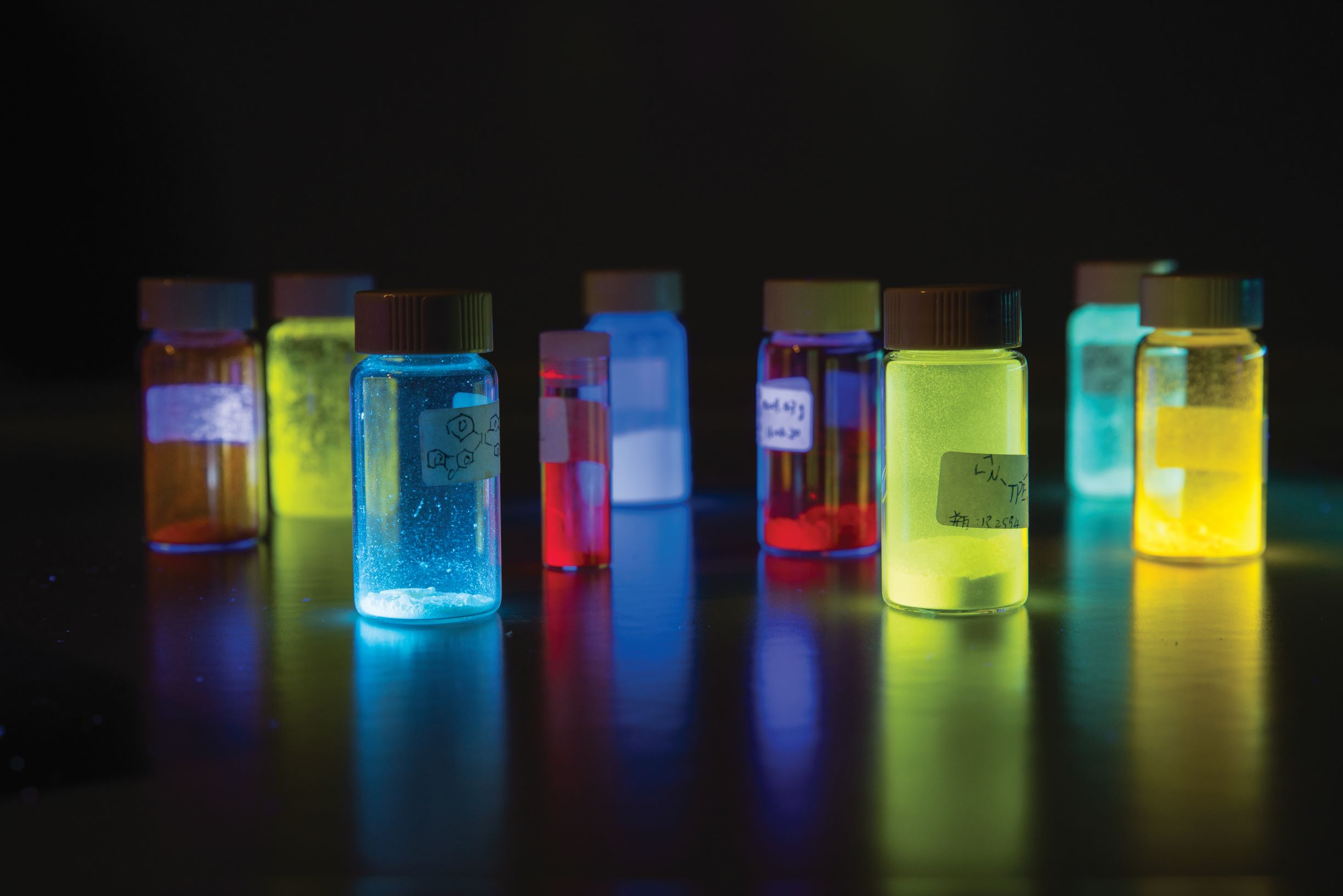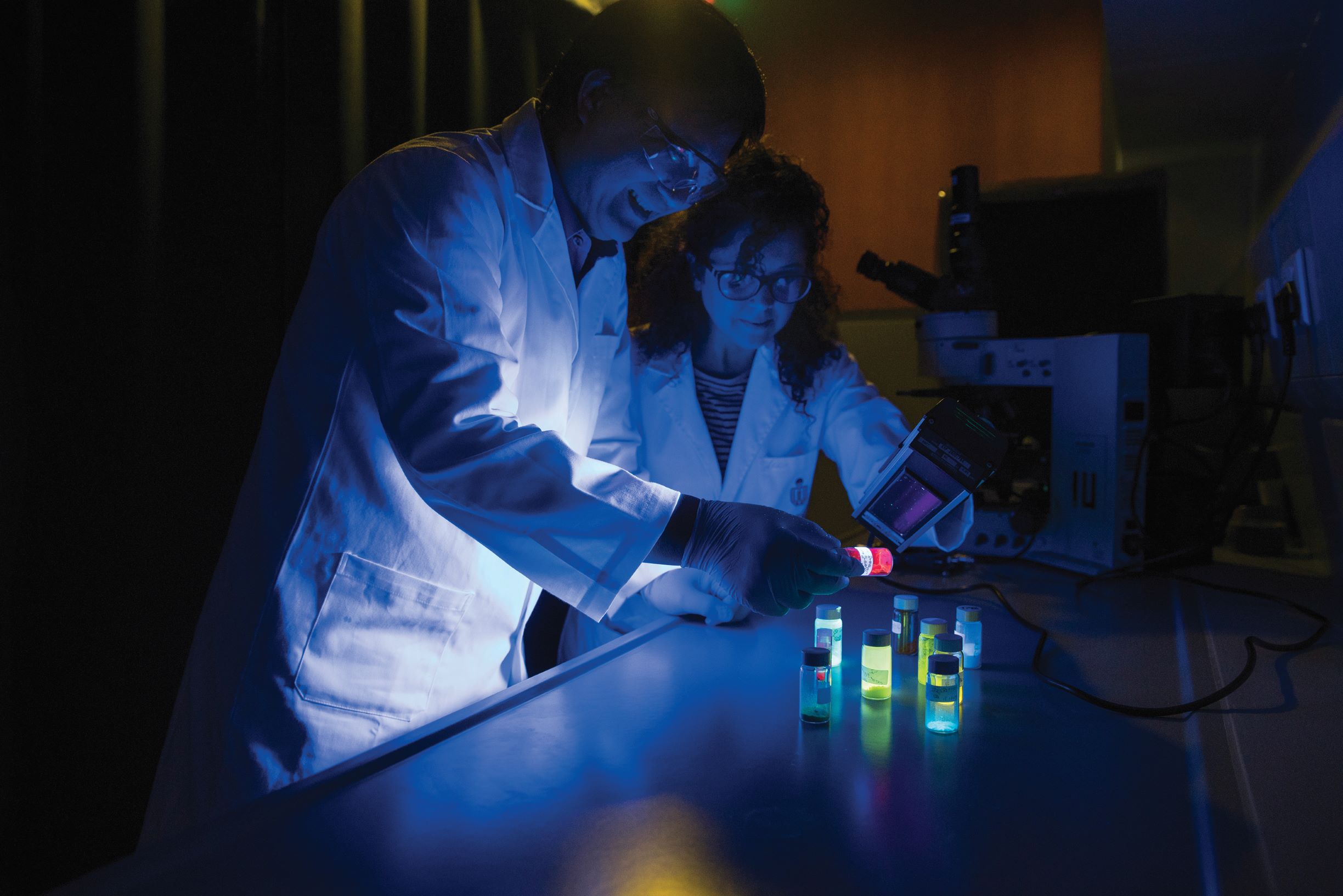Aggregation-induced Emission Luminogens: Smart Materials with Hi-tech Applications


Summary of Impact
The discovery of aggregation-induced emission (AIE) phenomenon by Chemistry researchers led by Prof Benzhong Tang has brought the development of more than 200 high-performance fluorescent materials with wide-ranging applications in bioimaging, food safety, healthcare, electronic displays, and forensic science, among others. The research has led to the establishment of a Chinese National Engineering Research Center (CNERC), two University-related companies in Hong Kong (AIEgen Biotech Co Ltd and AUISET Biotechnology Co Ltd), one start-up company in mainland China (Shenzhen AIEgen Biotech Co Ltd), and one start-up company in Singapore (Luminicell) to promote the research, development, and production of AIE source materials and products using the novel technology. Collaborations have been set up with enterprises to develop applications as diverse as food, gene detection, and biomedical testing probes; and forensic magnetic fingerprint powders, among many others.
Underpinning Research
In 2001, a chance observation during the purification process of a silole compound called 1-methyl-1,2,3,4,5-pentaphenylsilole (MPS) indicated that MPS does not luminesce when dissolved but does so on aggregation. Such a phenomenon is the exact reverse of the aggregation-caused quenching effect observed in traditional luminogenic materials, a consequence leading to many useful applications. The HKUST researchers led by Prof Tang published the results [See Section 3, R1], naming the phenomenon aggregation-induced emission (AIE). Through a series of experiments, the team discovered the intriguing mechanism behind AIE [R2], which lies in the shape of the molecule. Most light-emitting molecules are flat and stack together when crowded, which extinguishes their luminescence. By contrast, these molecules, named AIEgens by Prof Tang, are propeller-shaped, so they lock together when crowded and are forced to release their energy as luminescent photons. Since 2001, Prof Tang and his students changed the molecular structure and introduced additional units and elements such as nitrogen or oxygen, enabling AIEgens to glow across the entire spectrum of colors, from ultraviolet to near-infrared [R3].
The enthusiastic efforts of Prof Tang and his group have led to numerous breakthroughs and publications on this theme – with over 24,000 citations in 2015 and 40,000 citations in 2018 in the area of AIE. The many AIEgen materials generated by the team have been found to have particularly useful characteristics, such as their variety, tunable structures, good processability, and excellent biocompatibility. This has enabled them to be used in a broad range of chemistry, biochemistry, biomedical, and imaging applications. These include the development of optical waveguides; liquid crystals; stimuli-responsive materials; bioassays; DNA visualization techniques; protein fibrillation; and cell, bacteria and tissue imaging photodynamic therapies (including theranostics for bacteria and cancer treatment); ion and explosive detection; and magnetic fingerprint powders for use in crime control [R4, R5, R6].
The rapid rise of this new research area prompted the establishment of the Hong Kong branch of the Chinese National Engineering Research Center (CNERC) for Tissue Restoration and Reconstruction at HKUST in 2015, as approved by China’s Ministry of Science and Technology. From the Center, many applications using AIEgens have been developed, often in partnership with industry, resulting in nearly 100 patents. For example, luminogens fabricated into AIE dots were found to act as highly efficient fluorescent probes for in vivo deep-tissue imaging through a two-photon technique, outperforming the one-photon approach in penetration depth, and image contrast [R4]. They have been developed into a number of probes for biomedical, food safety and healthcare applications.
The significance of the AIE discovery and rapid development by Prof Tang’s team and the international research community has already been recognized by major awards, including the prestigious HLHL Foundation “Ho Leung Ho Lee Prize for Scientific and Technological Progress” in China in 2017. In the same year, the State Natural Science Award (First Class) was awarded to Prof Tang and his research partners at South China University of Technology and Beijing Institute of Technology. This is China’s highest accolade for scientific research. Internationally, Prof Tang was named a 2018 Web of Science/Clarivate Analytics Highly Cited Researcher, ranking in the top 1% by citations in Chemistry during the year.
Key Researchers: Prof Benzhong Tang, joined HKUST in 1994, Chair Professor since 2008. From 2001-05, during foundational AIE research, the team included postdoctoral fellows Jingdong Luo and Junwu Chen, and PhD student Yongqiang Dong.
Funding: The HKUST team has received 67 AIE-related competitive grants totaling HK$118 million, including Hong Kong Branch of National Engineering Research Center (HK$27.5 million), National Basic Research Program of China (973 Program) (HK$24.3 million) and two Collaborative Research Fund (RGC) (HK12.8 million). A total of 168 patents, many in the biomedical field, have been filed.
Details of the Impact
The discovery of AIE and development of its numerous applications has had wide-reaching and significant impact on: i) professional practice, by spawning a new area of research involving approximately 15,000 chemists, biochemists, and engineers in companies, research institutes, and universities globally; ii) the economy, through the Hong Kong branch of CNERC and four start-up companies created to develop and promote AIEgen applications for a range of technological innovations and products coming to the market; as well as to sell AIEgen materials to other researcher organizations; iii) public services, by providing new solutions for forensic investigations; iv) quality of life and health, through the development of AIE medical and food safety applications of AIE; and v) education, with AIE becoming a mainstream topic in science education in Chinese universities.
Since the initial discovery of AIE at HKUST, approximately 15,000 researchers globally, in industry, research institutes, hospitals and universities, in at least 82 countries, are now working on AIE-related topics, affirming significant and wide-reaching impact on professional practice. AIE materials have been supplied to world-leading medical establishments such as Harvard Medical School (US), Guy’s Hospital (UK), and the Biomedical Research Institute of Mercia (Spain). The impact on professional practice for scientific research was acknowledged by Thomson Reuters, which ranked AIE second on its “Top 100 Research Fronts” in Chemistry and Materials Science in 2015, and by Nature, which in 2016 listed AIEgens “as one of the unique luminescent materials that can revolutionize high technology applications”.
This impact on research globally is linked with economic impact being achieved by the CNERC research center and four start-up companies established by Prof Tang and his colleagues and partners in Hong Kong, mainland China, and Singapore, with subsequent impacts on quality of life and human health, and impact on public services for law enforcement. CNERC focuses on developing and producing new luminescent materials and hi-tech applications of AIEgens in collaboration with industry. The center provides an international platform for technical collaborations in the fields of luminescent and biomedical materials through technological development, incubation, and transfer.
The center has attracted funding from industry to develop AIE applications and built a global sales network for AIEgen materials. The investment from Hybribo Limited, a leading provider of in vitro diagnostic assays in China, has supported the development of a gene detection platform based on AIEgens to be used for fast screening of bacterial and viral infections, and rapid detection of micro-organisms in food. CNERC also collaborates with Guangzhou Yingzhou Law Enforcement Technology Ltd (GYLET) to manufacture and commercialize AIEgen-based magnetic fingerprint powder for use in forensic work. The first 100 kg of the AIE fingerprint powder has been synthesized by CNERC and supplied to GYLET for sale in Guangdong Province.
In addition, AIEgens are being used to develop a wide range of probes that, together with other AIE applications, are now being commercialized through four start-up companies formed by Prof Tang and his colleagues:
AIEgen Biotech Co Ltd, established in Hong Kong in 2016 with Prof Tang as major shareholder and chief scientific officer. This company licensed HKUST technology and signed an agreement with MilliporeSigma (now Merck), a leading provider of lab materials, as the overseas distributor of AIEgens. In 2016, 12 AIEgens were sent to MilliporeSigma. In 2017, another eight materials were sent. This production and supply network provides researchers globally with the fluorescent materials to develop new-generation bioprobes and chemosensors. Since August 2017, the company extended its reach through a collaboration with Funakoshi Co Ltd in Japan to promote AIEgens in the Japanese market; a sales network in Korea through Edithgen Co Ltd; and in China through Sambo Co Ltd.
Shenzhen AIEgen Biotech Co Ltd was set up in December 2016 to widen the AIEgens market and is now working with ZhongkeLonggang Investment Management Co Ltd to sell AIE materials to researchers for bio-imaging and bacteria screening. The company also authorized Huawei Ruike Co Ltd to promote and sell AIE products.
Luminicell was set up in Singapore in 2015 by Prof Tang and Prof Bin Liu (National University of Singapore), and licensed by HKUST to develop new-generation bio-imaging products, including two commercial cell trackers for imaging in vitro or in vivo systems, for use in the biotechnology and pharmaceutical research industries. The company developed and markets LuminiCell Trackers, which provide real-time cell tracing with three times the duration and ten times the brightness of existing tools. They are used by researchers to image cell behavior and enable new diagnostic and therapeutic capabilities for cancer, infectious disease, vascular disease and other conditions. The Merck platform is used for sales.
AUISET Biotechnology Co Ltd was established in 2018 to market paper strips for personal hormone monitoring and early pregnancy testing, for use to address fertility issues.
The AIE research is also having impact on education. Universities in mainland China, such as Zhengzhou University, Hangzhou Normal University and Harbin Institute of Technology, Shenzhen, have included the AIE science concept in their undergraduate courses, designed teaching experiments for the AIE phenomenon and AIEgens preparation, and used AIE as a topic for open examination.
References to the Research
[R1] Luo, J; Xie, Z; Lam, JWY; Cheng, L; Chen, H; Qiu, C; Kwok, HS; Zhan, X; Liu, Y; Zhu, D; Tang, BZ. “Aggregation-induced Emission of 1-Methyl-1,2,3,4,5-pentaphenylsilole” Chem. Commun. 2001, 1740–1741 (3,030 citations, Web of Science 12/8/2019)
[R2] Chen, J; Law, CCW; Lam, JWY; Dong, YP; Lo, SMF; Williams, ID; Zhu, D; Tang, BZ “Synthesis, Light Emission, Nanoaggregation, and Restricted Intramolecular Rotation of 1,1-Substituted 2,3,4,5-Tetraphenylsiloles” Chem. Mater. 2003, 15, 1535–1546 (802 citations, Web of Science 12/8/2019)
[R3] Hong, Y; Lam, JWY; Tang, BZ. “Aggregation-Induced Emission: Phenomenon, Mechanism and Applications” Chem. Commun. 2009, 4332–4353 (2,123 citations, Web of Science 12/8/2019)
[R4] Mei, J; Leung, NLC; Kwok, RTK; Lam, JWY; Tang, BZ. “Aggregation-Induced Emission: Together We Shine, United We Soar!” Chem. Rev. 2015, 115, 11718–11940 (2,037 citations, Web of Science 12/8/2019)
[R5] Mei, J; Hong, YM; Lam, JWY; Qin, AJ; Tang, YH; Tang, BZ. “Aggregation-Induced Emission: The Whole Is More Brilliant than the Parts” Adv. Mater. 2014, 26, 5429−5479 (1,238 citations, Web of Science 12/8/2019)
[R6] Hong, Y; Lam, JWY; Tang, BZ. “Aggregation-Induced Emission” Chem. Soc. Rev. 2011, 40, 5361–5388 (2,903 citations, Web of Science 12/8/2019)